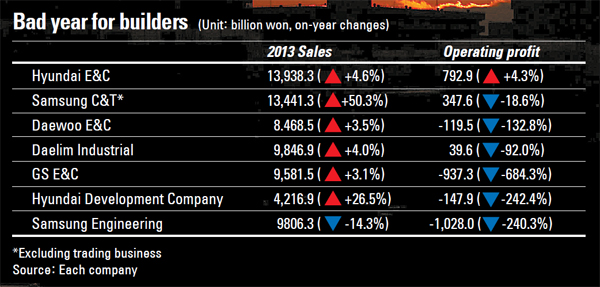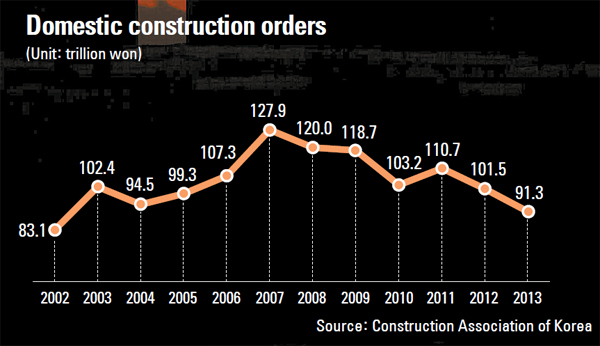Profits plummeted at construction companies

Major Korean builders reported significant plunges in operating profits, with Hyundai Engineering and Construction being the exception. Despite a slump in the fourth quarter of 2013, the nation’s largest builder, which is under Hyundai Motor Group, reported its 2013 operating profit increased 4.3 percent year-on-year to 792.9 billion won ($735 million), while sales increased 4.6 percent to 13.93 trillion won.
No. 2 player Samsung C&T said it earned only 347.6 billion won in operating profit last year, down 18.6 percent from a year before, although its sales improved 50.3 percent year-on-year to 13.44 trillion won. No. 4 builder Daelim Industrial saw its 2013 operating profit drop 92 percent to 39.6 billion won.
Some construction companies went into the red. Korea’s third-largest builder, Daewoo E&C, said it had an operating loss of 119.5 billion won in 2013, while Hyundai Development Company (HDC) lost 147.9 billion won.
Samsung Engineering reported an operating loss of more than 1 trillion won in 2013, with sales dropping 14.3 percent year-on-year to 9.8 trillion won. GS E&C said yesterday its operating loss reached 937.3 billion won in 2013, declining by more than 1 trillion won from the previous year.

However, analysts say reports of local builders’ poor 2013 earnings were partly a strategic accounting decision as they decided to “big bath” losses last year.
This accounting technique forces the company to report a poor performance that will make future earnings look better. It is usually implemented after an especially bad year in which the company wouldn’t have had good results anyway. It is sometimes used when a new CEO wants to blame the company’s unsatisfactory performance on his predecessor and take credit for an improvement the following year.
Daelim Industrial reported 535.9 billion won in expenses in the fourth quarter after calculating possible losses from construction projects in Saudi Arabia and Kuwait as labor and equipment costs rise. Although the builder receives revenue from the project in each construction phase, it decided to write off its expenses in advance.
HDC also reported that it applied expected future losses on construction projects in Daegu and Ulsan, while Daewoo E&C is known to be applying more than 1 trillion won in possible losses in the fourth quarter, according to Kang Seung-min, an analyst at NH Investment and Securities.
“Overseas, Daewoo E&C applied a 250 billion won loss for rising costs and a 70 billion won loss coming from its Libya unit,” Kang said yesterday in a report. “In Korea, the company precalculated losses of 790 billion won.”

Unlike regular financing, in which a borrower offers its assets as collateral for a loan, in project financing a borrower offers the future benefits of construction projects as collateral. But with a sluggish housing market, builders are unable to sell apartments, while some are even struggling to start construction on projects.
The Korean stock market is welcoming construction companies’ clearing of losses on their balance sheets.
“Because of major builders’ conservative accounting last year, the market seems to have more expectations of a normalization of their business,” said Kim Hyun-gun, an analyst at Meritz Securities. “As they continue to clear problems in unprofitable construction projects in the first quarter, there could be a turnaround from the second half of this year.”
Despite its poor report, HDC’s stock rose 8.4 percent in the last two days, while Daewoo E&C’s rose 20 percent in a week. GS E&C and Samsung Engineering’s stocks also rose more than 4 percent yesterday.
Analysts say construction stocks are rising because of improved prospects for future earnings and the idea that companies will be more cautious about bidding for overseas construction projects in the future.
“We are not going to make the same mistake we did in the past,” said an employee at a major construction company. “These days, instead of entering a bidding on their own, more builders are forming a consortium with other companies to reduce risks in overseas projects.”
Meanwhile, it seems major builders need to go overseas because the value of domestic orders is declining. According to data from the Construction Association of Korea (CAK), the total value of construction orders in 2013 was only 91.3 trillion won, the lowest figure since 2002’s 83.1 trillion won. A drop in orders from the private sector was the main culprit.
“2013 is the year the construction industry doesn’t even want to remember,” the CAK said in a release. “Although a positive atmosphere looms over the housing market at the beginning of this year, we have to see whether it will continue throughout. We hope this year will be a turning point for the industry both in quantity and quality.”
BY JOO KYUNG-DON [kjoo@joongang.co.kr]










with the Korea JoongAng Daily
To write comments, please log in to one of the accounts.
Standards Board Policy (0/250자)